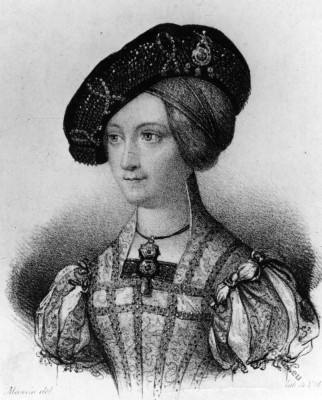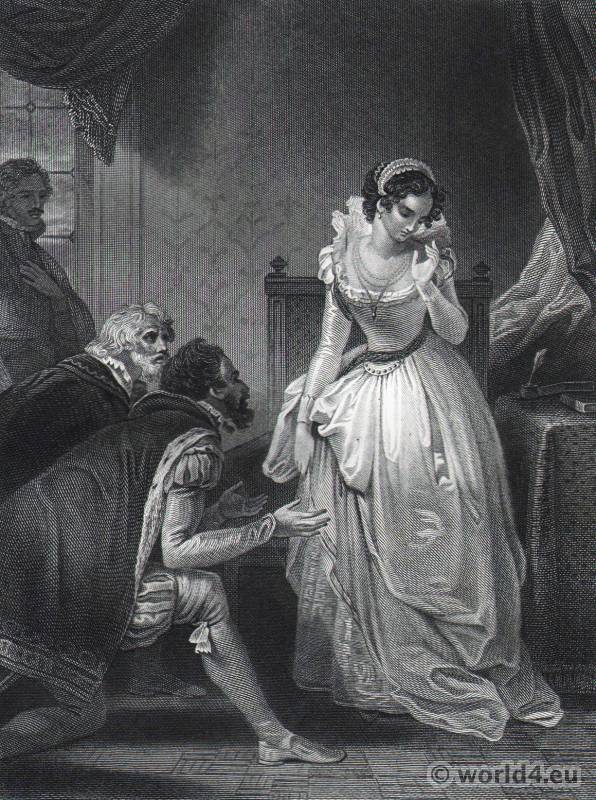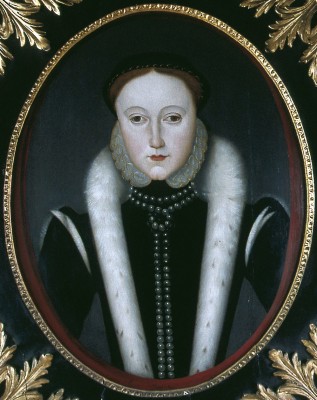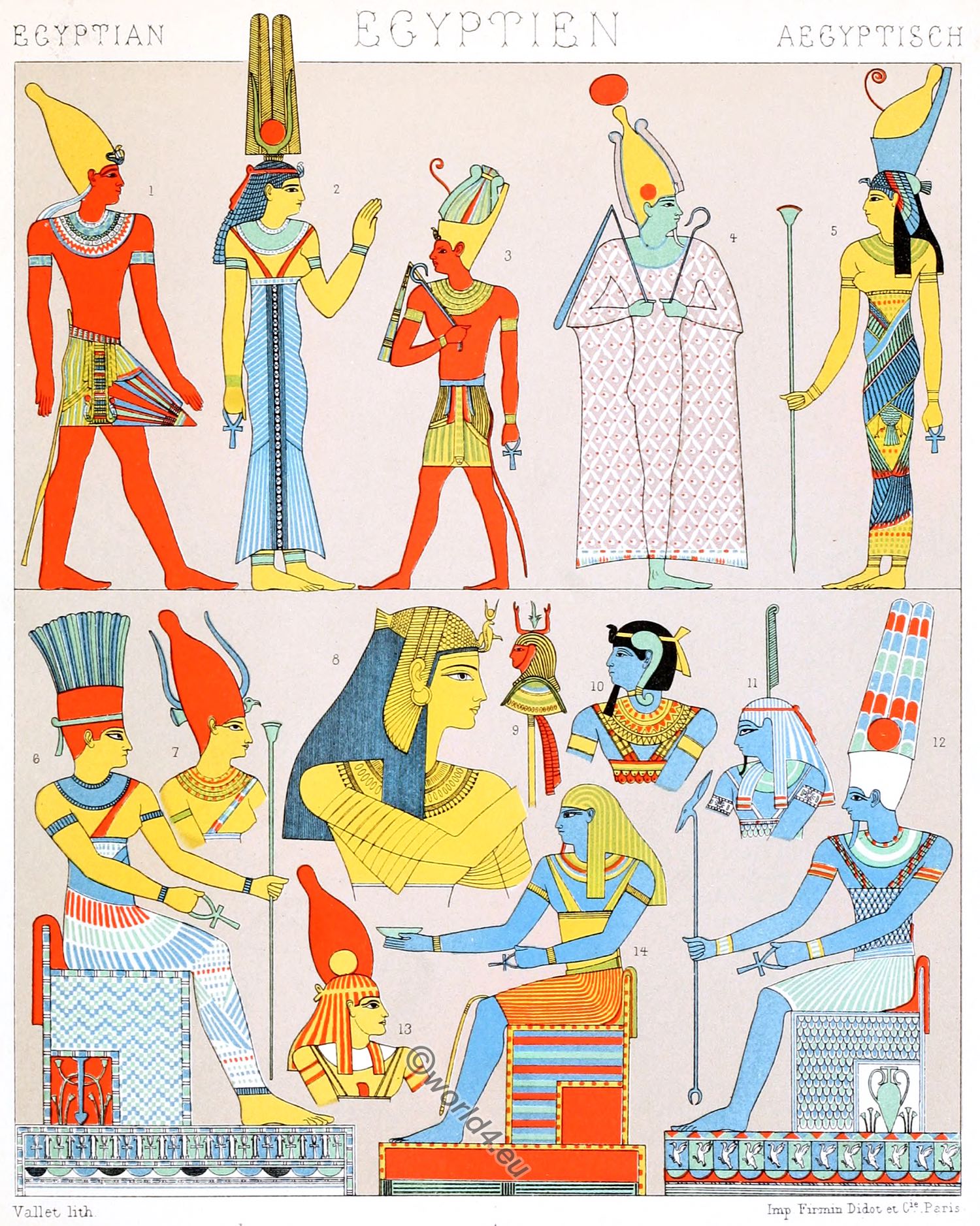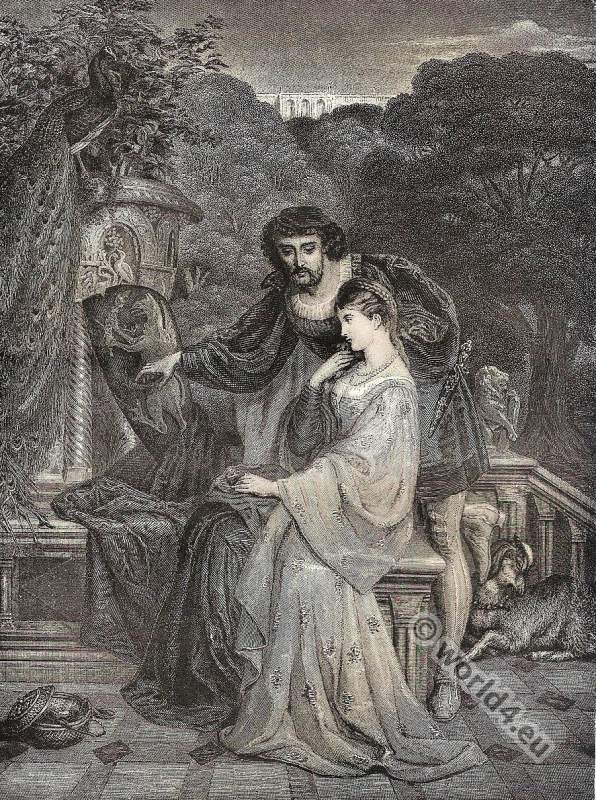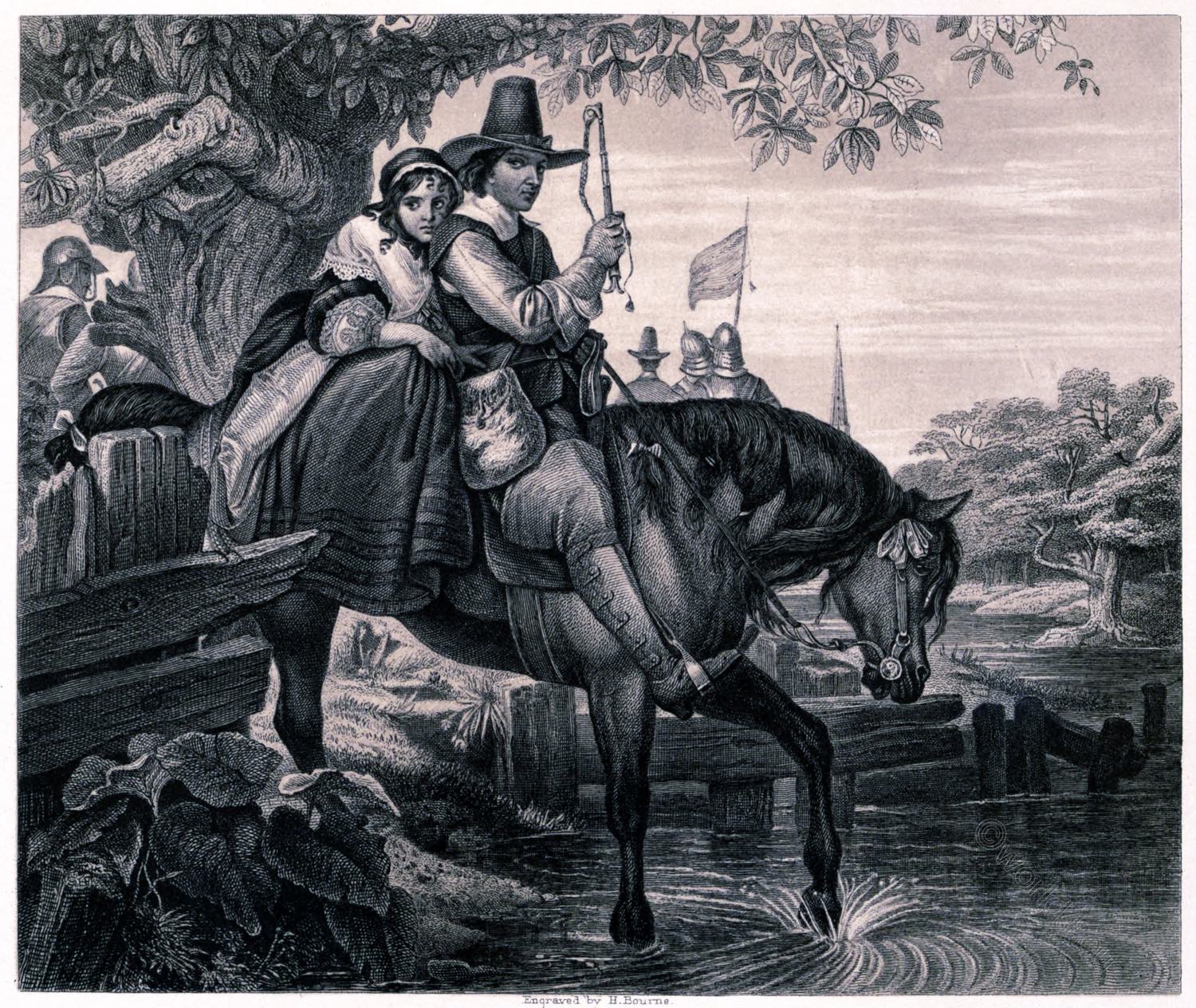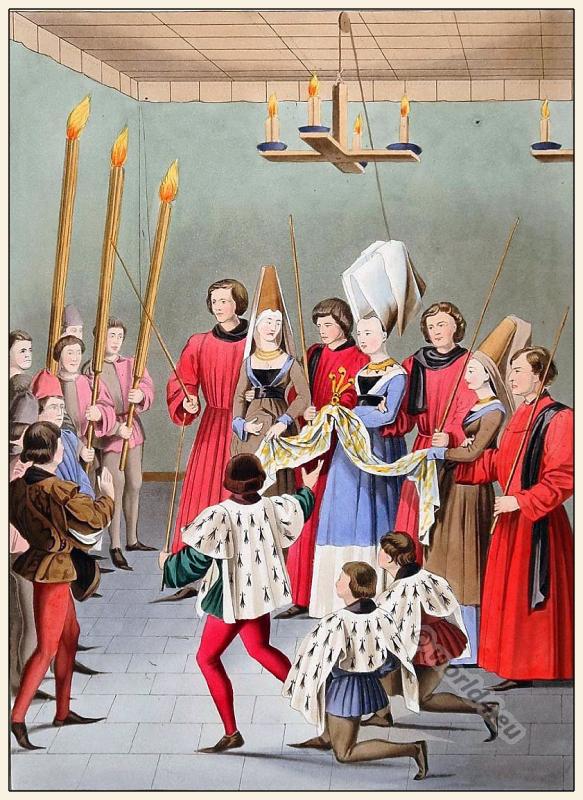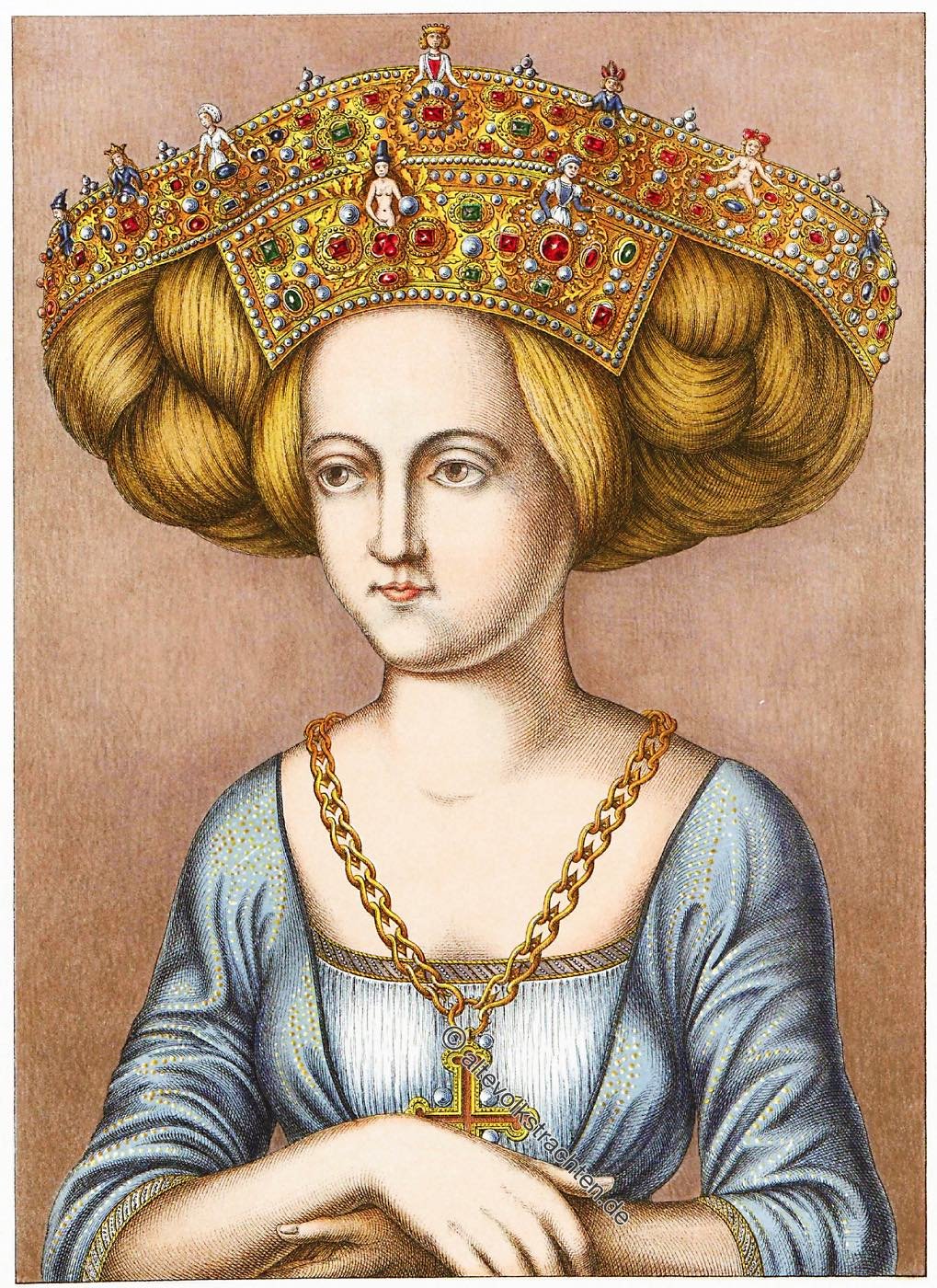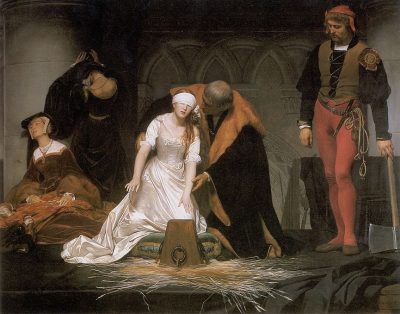
The offer of the crown to Lady Jane Grey.
Lady Jane Grey (*1536/1537-1554), the official heiress of King Edward VI, claimed the title of Queen of England from 10 to 19 July 1553. Since then she has had the nickname Queen of the Nine Days or Queen of the Thirteen Days. However, she was defeated by Maria I.
“She has left a portrait of herself, drawn by her own hand— a portrait of piety, purity, and free noble innocence, uncolored even to a fault with the emotional weaknesses of humanity.
These are the words of Mr. Froude in speaking of that “twelfth day” queen of England, whose name appears in history without a royal title, and only as Lady Jane Grey. Amidst the sickening incense of flatterers, the fury of persecution, the intrigues of factions, this pure and gentle lady appears in the record of the time an almost solitary figure, and her name even now thrills a responsive chord in every sympathetic heart. Not as the daughter of Henry Grey, duke of Suffolk, but through her mother, Frances Brandon, niece of Henry VII., she stood next to Mary and Elizabeth as successor to the English crown.
We have already noted how, during the illness of Edward VI., the impetuous and unscrupulous Dudley, duke of Northumberland, brought about a marriage between her and his son the Lord Guildford Dudley. She was then only seventeen, but her great accomplishments, the strength of her understanding, and the firmness and yet gentleness of her character, gave her a dignity which enabled her to support the trials through which she was so soon afterwards to be made a martyr to wrongful ambition.
In an age when women of high rank were not only accomplished but learned, Lady Jane Grey was distinguished for her attainments. She was acquainted with the Greek, Latin, Italian, and French languages, and had some acquaintance with Hebrew and Arabic. She was a favourite scholar of the learned Roger Ascham, and with the reformer Bullinger she corresponded in Latin as correct as his own. Out of regard for her youth, and perhaps that she might remain ignorant of the intrigue in which she was soon to be involved, she and Lord Guildford Dudley, the boy to whom she had been married, were allowed for a time to reside with her mother in the country, but when Edward’s death became imminent she was summoned to her father-in-law’s house and informed that the king had appointed her to be heir to the crown.
The intelligence was treated by Lady Jane Grey as a jest: she was utterly averse to the whole proposal; but the Duchess of Northumberland, after a stormy scene with the Duchess of Suffolk, carried the young bride off with her. On the 9th of July, three days after the king’s death, which had been kept secret, Lady Jane was requested to be at Sion House, and upon her arrival was waited on by Northumberland and other lords, his fellow conspirators.
“The Duke of Suffolk, with much solemnity, explained to his daughter the disposition the late king had made of his crown by letters patent, the clear sense the privy council had of her right, and the consent of the magistrates and citizens of London, and in conclusion himself and Northumberland fell on their knees, and paid homage to her as Queen of England.
The poor lady, somewhat astonished at their behavior and discourse, but in no respect moved by their reasons, or in the least elevated by such unexpected honors, answered them ‘that the laws of the kingdom and natural right standing for the king’s sisters, she would beware of burdening her weak conscience with a yoke that did not belong to them; that she understood the infamy of those who had permitted the violation of right to gain a sceptre; that it were to mock God and deride justice.
Besides,’ said she, ‘I am not so young nor so little read in the guiles of Fortune as to suffer myself to be taken by them. … What she adored but yesterday is to-day her pastime. … My liberty is better than the chain you proffer me, with what precious stones soever it be adorned, or of what gold soever framed. I will not exchange my peace for honorable and precious jealousies, for magnificence and glorious fetters. And if you love me in good earnest you will rather wish me a secure, a quiet fortune, though mean, than an exalted condition exposed to the wind, and followed by some dismal fall.'”
All the moving eloquence of this speech had no effect, and the Lady Jane was at length prevailed on, or rather compelled, by the exhortations of her father, the intercessions of her mother, the artful persuasions of Northumberland, and, above all, the earnest desires of her husband, whom she tenderly loved, to comply with what was proposed to her.
The next day she was conveyed by water to the Tower, and there publicly received as queen by some of the citizens and other persons. It was only a mock reign of ten days, and then the Tower, instead of a royal palace, became a prison. Mary, who had retired on having been informed of Northumberland’s plot, was already advancing with an armed force; and the people, who were more in favor of the direct succession than in fear of Popery, were everywhere well-affected towards her; even the citizens were silent and unresponsive when Lady Jane Grey was proclaimed, and the people of Suffolk, Norfolk, and Cambridgeshire, who detested Northumberland for his severity in repressing their rebellion, were ready to support Mary’s cause, while the noblemen who were not at the Tower with the council and the supposed adherents of the new regime hastened to give her their aid. It was evident that the plot had failed, and were it not for the innocent victim of that conspiracy we could scarcely be sorry for it. The intriguing crew were false to each other and to the cause which they professed to maintain.
Northumberland feared to leave everything to the treachery of the council, while they on their part were pressing him to go at the head of an army to oppose the approach of Mary. He had at first intended to intrust the command to Suffolk, but Suffolk was not a distinguished commander; and the new queen besought that her father should stay with her—the father who himself was little less false and selfish than the rest. Northumberland went out himself towards Norfolk at the head of a small army, after appealing to the good faith and sentiments of the council.
As he marched with his force of 6000 men through the city his spirits fell, for the people looked on and none wished him God-speed. As to the council, they seem to have made up their minds to desert him and all their recent oaths, and to declare for Queen Mary as soon as his back was turned. Ridley alone appears to have been stanch to the revolution in order to prevent the return of Papistry, but on the Sunday when he preached at Paul’s Cross on behalf of the Lady Jane, and against both Mary and Elizabeth, the Londoners listened in silence.
On the same day the lord-treasurer stole out of the Tower to his house in the city, evidently to make arrangements for the council going over in a body to Mary. At night he returned, and two days after Cecil, Cranmer, and the rest of the councillors persuaded Suffolk to levy fresh forces, and to place them at their disposal. Meantime, in order to be better able to support the cause of his daughter, they were to leave the Tower, and hold their sittings at Baynard’s Castle, then the residence of the Earl of Pembroke. Here they at once declared for Queen Mary, and instantly despatched the Earl of Arundel, Sir William Paget, and Sir William Cecil to notify their submission and “exceeding great loyalty.”
The lord-mayor and aldermen were sent for and told that they must ride with them into Cheap, and there proclaim a new queen, where Master Garter-king-at-arms, in his rich coat, stood with a trumpet, and the trumpet being sounded they proclaimed the Lady Mary, daughter to King Henry VIII. and Queen Catharine, to be Queen of England, France, and Ireland, defender of the faith, and supreme head of the church, and to add more majesty to their act by some devout solemnity, they went in procession to Paul’s singing that admirable hymn of those holy fathers St. Ambrose and St. Augustine commonly known by its first words Te Deum.”
Who can follow subsequent events without some feeling of wonder and shame at the prevailing cowardice and treachery, the ignoble ending of some of the men concerned, and the duplicity of others? The next move was to send some of the companies of men-at-arms at their disposal to besiege the Tower. There was no need. The Duke of Suffolk opened the gates at once, went and told his daughter that she must be content to return to private life (at which she rejoiced), and while she was at prayer in an inner room posted off to Baynard’s Castle to join the rest of the council in savour of Queen Mary.
The Duke of Northumberland was only a little behindhand. He had reached Cambridge the day after the proclamation in Cheap, and being apprised of the fact at once went with such of the nobility as were in his company to the market cross, and calling for a herald proclaimed Queen Mary, and was the first to throw up his cap and cry, “God save her!” This did not save his own neck. When he was afterwards brought to trial, he asked whether any such persons as were equally culpable with him, and those by whose letters and commandments he had been directed in all his doings, might be his judges or sit upon his trial as jurors, but the question was of no avail. Cranmer, Cecil, and the rest, who averred that they had acted in peril and had been coerced by the duke, tried and condemned him.
Before the coronation Cranmer was arrested. He was the greatest enemy of Catharine of Aragon, and the most eminent of the Protestant reformers, so we need not wonder that Mary had determined to bring him to death, even without the additional motive that at this time, assisted by the learned Peter Martyr, he wrote (some say, published, but perhaps the documents were only treacherously conveyed to the queen) a manifesto of the Protestant faith and his abhorrence of Popish superstitions.
These superstitions were soon restored, the ‘prisons began to be filled with Protestant clergymen, the mass was read and the service of the church conducted in Latin, and except in London and the great cities where Protestantism had taken deeper root, every part of the reformed service was almost immediately thrown aside. Persecutions, fines, imprisonments, and all kinds of barbarities followed. Pestilence and death added their terrors to the scene, and public morality was at a low ebb. Crime and cruelty went together.
From the martyrdom of John Rogers, who suffered on the 4th of February, 1555, about six months after Mary’s accession, to the last five victims who were burned at Canterbury on the 10th November, 1558, only seven days before her death, not fewer than 288 individuals, among whom were five bishops, twenty-one clergymen, fifty-five women, and four children, were burned indifferent places for their religious opinions; and in addition to these, several hundreds were tortured, imprisoned, starved, and ruined. Of course to these are to be added a host of executions for felonies and offenses against the laws, and these commenced with Northumberland and those who were his immediate abettors in the proclamation of Lady Jane Grey as queen.
This was on the 22nd of August, 1553.
The innocent victim of their plots, though she had been sentenced to death and was kept a prisoner at the Tower, might have remained alive but for Wyatt’s rebellion. Mary was made to believe that the safety of the crown could only be secured by the execution of the sentence, and on the 12th of February, 1554, Lord Guildford Dudley was delivered to the sheriffs and conducted to the scaffold on Towerhill. On that dreadful morning the Lady Jane had declined a meeting with him, saying that it would rather increase their grief than be a comfort in death, and that they should shortly meet in a better place and a more happy estate. She saw him conducted to Tower-hill, and with a dauntless but gentle spirit, waiting for immortality, beheld his headless trunk as it was brought back for burial.
It was seared that the sympathy of the people for this young and faultless woman would be dangerous, and therefore her scaffold had been made ready on the green within the verge of the Tower, and almost as soon as her husband’s body had passed she was led forth to her death. Fecknam, the very catholic dean of St. Paul’s, had tormented her last hours with disputations and arguments, but her faith remained unshaken.
She went “in countenance nothing cast down, neither her eyes anything moistened with tears, although her gentlewomen, Elizabeth Pilney and Mistress Helen, wonderfully wept.”
She had a book in her hand wherein she prayed until she came to the scaffold. She addressed the few bystanders, saying that she had deserved her punishment for suffering herself to be made the instrument, though unwillingly, of the ambition of others, and that she hoped her fate might serve as a memorable example in after-times. She then implored God’s mercy, caused herself to bed is robed by her gentlewomen, veiled her own eyes with her handkerchief, and laid her head on the block, exhorting the lingering executioner to the performance of his office. At last the axe fell, and her lovely head rolled away from the body, drawing tears from the eyes of the spectators, yea, even of those who from the very beginning were best affected to Queen Mary’s cause.
Source: Pictures and Royal Portraits illustrative of English and Scottish History by Thomas Archer. London 1878.
Discover more from World4 Costume Culture History
Subscribe to get the latest posts sent to your email.

